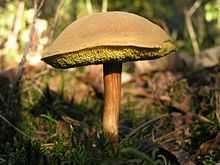Xerocomus
| Xerocomus | |
|---|---|
 | |
| Xerocomus subtomentosus | |
| Scientific classification | |
| Kingdom: | Fungi |
| Division: | Basidiomycota |
| Class: | Agaricomycetes |
| Order: | Boletales |
| Suborder: | Boletineae |
| Family: | Boletaceae |
| Genus: | Xerocomus Quél. (1887) |
| Type species | |
| Xerocomus subtomentosus (L.) Quél. (1888) | |
Xerocomus is a genus of fungi that is related to Boletus. Many mycologists do not recognize the distinction; however, several molecular studies have demonstrated that they are two distinct genera, with clear morphological differences. The genus Xerocomus has been further divided into Xerocomellus and Hemileccinum by Šutara (2008).[1] The members of the Xerocomellus genus are more closely related to Boletus than true Xerocomus is, which is relatively distantly related to Boletus and more closely related to Phylloporus.
Most members of Xerocomus are edible.
Ladurner and Simonini published a monograph on Xerocomus in 2003.[2] In 2008, Hills included 18 species found in Britain, not including some species sometimes treated as Xerocomus, including Boletus pulverulentus and Boletus impolitus.[3]
Molecular phylogenetic studies strongly imply that Xerocomus is a heterogeneous genus of polyphyletic origin.[4]
Species
- Xerocomus armeniacus
- X. badius (edible and often known as Boletus badius)
- X. belizensis
- X. bubalinus
- X. cisalpinus
- X. chrysenteron (edible and very common, actually a Xerocomellus and the type species of the genus)
- X. chrysonemus
- X. communis
- X. cyaneibrunnescens – Guyana[5]
- X. fennicus
- X. ferrugineus
- X. guidonis
- X. moravicus
- X. olivaceus
- X. parvogracilis – Guyana[5]
- X. porophyllus – China[6]
- X. porosporus
- X. potaroensis – Guyana[5]
- X. pruinatus
- X. ripariellus
- X. rubellus
- X. silwoodensis (edibility not known, found in England, Spain, and Italy. Named seventh top species of 2008, International Institute for Species Exploration[7])
- X. subtomentosus (edible and very common)
- X. truncatus (edible and very common)
Description
Morphological features of xerocomoid boletes[8][9][1]
| Boletus s.str. | Hemileccinum | Xerocomellus | Xerocomus s.str. | |
|---|---|---|---|---|
| Spore Surface | Smooth | Smooth | Longitudinally striated or smooth, never bacillate | Bacillate |
| Hymenophoral trama | Boletoid type with gelatinous lateral strata | Boletoid type with gelatinous lateral strata | Intermediate between boletoid and phylloporoid when fully developed with distinct but weakly gelatinous lateral strata | Phylloporoid type with nongelatinous lateral strata |
| Pileipellis | Trichoderm, sometimes collapsing, rarely ixotrichoderm or other | Initially trichoderm but collapses with age | Initially palisadoderm, typically encrusted | Initially a trichoderm, never encrusted |
| Lateral stipe stratum | Frequently gelatinous, 60-90 μM thick, thicker than that of Xerocomellus | Similar to that of Leccinum species, ornamented with stipe scabrousities up to 400-640 μM thick | Frequently not present, reduced to no more than 30-40 μM thick, not gelatinous | Lateral stipe stratum never gelatinous and 80-200 μM thick |
References
- ↑ 1.0 1.1 Šutara J. (2008). "Xerocomus s.l. in the light of the present state of knowledge". Czech Mycology 60 (1): 29–62.
- ↑ Ladurner H, Simonini G. (2003). Xerocomus s.l. Fungi Europaei 8. Alassio: Edizioni Candusso. ISBN 978-88-901057-2-2.
- ↑ Hills AE. (2008). "The genus Xerocomus: A personal view, with a key to the British species". Field Mycology 9 (3): 77–96. doi:10.1016/S1468-1641(10)60416-1.
- ↑ Nuhn ME, Binder M, Taylor AFS, Halling RE, Hibbett DS. (2013). "Phylogenetic overview of the Boletineae". Fungal Biology 117 (7–8): 479–511. doi:10.1016/j.funbio.2013.04.008. PMID 23931115.
- ↑ 5.0 5.1 5.2 Husbands DR, Henkel TW, Bonito G, Vilgalys R, Smith ME. (2013). "New species of Xerocomus (Boletales) from the Guiana Shield, with notes on their mycorrhizal status and fruiting occurrence". Mycologia 105 (2): 422–35. doi:10.3852/12-146.
- ↑ Yan W-J, Li T-H, Zhang M, Li T. (2013). "Xerocomus porophyllus sp. nov., morphologically intermediate between Phylloporus and Xerocomus". Mycotaxon 124: 255–62. doi:10.5248/124.255.
- ↑ http://www.species.asu.edu/2008_species07.php
- ↑ Šutara, J. (1989). "The delimitation of the genus Leccinum". Ceská Mykologie 43: 1–12.
- ↑ Šutara J. (1991). "Pseudoboletus, a new genus of Boletales". Ceská Mykologie 45 (1-2): 1–9.
External links
- The genus Xerocomus
- Xerocomus chrysenteron
- Xerocomus subtomentosus
- Xerocomus truncatus
- Xerocomus zelleri
| Wikimedia Commons has media related to Xerocomus. |